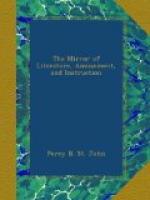The bull-fights in Lisbon are a very inferior species of amusement to this, though much better than I was led to anticipate. Here the bulls are generally not so strong or so spirited as the Spanish breed. In the morning of the sport, the tips of their horns, instead of being left sharp, are covered with cork and leather. None but one horseman appeared in the ring at a time—no havoc was of course made among the horses; bulls were introduced and baited without being killed, and the matador, though he sometimes displays the same dexterity, never encounters the same danger as in Spain. In Lisbon the most interesting part of the sport consists in an operation which could not be practised in Spain, and is conducted by performers who are unknown where bull-fighting is more sanguinary. These performers are what they call here homens de furcado, or men of the fork; so denominated from their bearing a fork with which they push or strike the head of the bull, when he throws down a man or a horse. After the bull, not destined to be killed, has afforded amusement enough, these men go up before him, one of them trying to get in between his horns, or to cling to his neck, till the rest surround, master him, and lead him out of the area. The man of the fork, who gets between the bull’s horns, is sometimes tossed in the air or dashed to the ground, and in this one of the chief dangers of the fight consists. On Sunday one of them was dashed down so violently as to be carried out of the ring in a state of insensibility. Only four bulls were killed out of the twelve exhibited. The rest being reserved for future sport, were either dragged out of the ring in the manner above described, or, when supposed to be too strong to be mastered by the men of the fork, were tamely driven out among a flock of oxen introduced into the area as a decoy. Another peculiarity of the Lisbon bull-fights is the presence of a buffoon on horseback called the Neto, who first enters the ring to take the commands of the Inspector, and occasionally bears the shock of the bull, to the no small diversion of the lower class of spectators. The Spanish bull-fight is too serious an affair for a buffoon: it is a tragedy, and not a farce.




